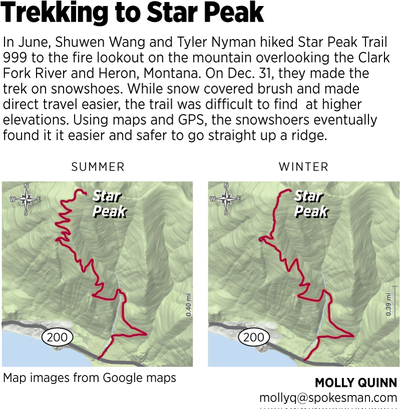Webfooters go with the snow

Trails are handy for snowshoeing, but they’re not essential.
Three or more feet of snow often covers brush and boulders to open bigfooter walking options in almost every direction.
The main requirement might simply be a plowed place to park a vehicle. Beyond that, snowshoeing is open to adventures ranging from strolls to serious buttbusters.
Excellent snowshoeing trails can be found at Mount Spokane State Park, where a Washington Sno-Park permit is required on vehicles. A favorite route runs from from the snowmobile parking lot at 4,500 feet up to Bald Knob picnic area at elevation 5,100 feet.
From there, snowshoers looking to burn more calories and snag better views can head up the open south slope of the mountain to the summit past the ski area lifts to the Vista House at 5,883 feet.
A map of this and other good routes on the Mountain is posted on the Friends of Mount Spokane State Park website, mountspokane.org.
Warming huts for snowshoers have been installed by state park rangers and volunteers at Mount Spokane. At Fourth of July Pass, two shelters are maintained by the Panhandle Nordic Club. A warming cabin is available along the trails at Frater Lake east of Colville.
Spokane County Conservation Futures areas also are magnets for snowshoeing. Favorites include Antoine Peak, Liberty Lake, Dishman Hills, Slavin and Mica Peak. All are detailed on the county’s website, spokanecounty.org.
Iller Creek and the Rocks of Sharon areas are favorites. Fresh snow lures many snowshoers to make the climb up to Big Rock from the Stevens Creek trailhead. In fact, these trails are so popular snowshoes aren’t needed once the routes become packed.
Bring boot traction devices such as YakTrax or MICROspikes in that case and leave the snowshoes behind.
Various neighborhoods have their own snowshoeing getaway spots. North Spokane has a gem of a route heading into Washington Department of Fish and Wildlife property along the Little Spokane River. The state’s small parking area (Discover Pass required) is off Fairwood Drive in the Bellwood neighborhood east of the Bozarth Retreat.
The route had been well packed by snowshoers within a day of last weekend’s snowfall and usable by walkers in boots by Monday.
Of course, many options farther from towns will get snowshoers away from crowds and packed trails. Indeed, traveling in groups of three or more helps extend the range of a snowshoeing trek by sharing the work of breaking trail at, say, the Little Pend Oreille National Wildlife Refuge southeast of Colville.
National forests offer nearly endless snowshoeing options, including winter-trekking hotspots such as Sherman Pass.
A lot of the work volunteers devoted to re-routing the trail to Star Peak on the Kootenai National Forest went unnoticed by a pair of Spokane Mountaineers on New Years Eve, buried under 5 feet of snow. But snowshoers Tyler Nyman and Shuwen Wang broke trail up through the forest and above timberline to find the fire lookout caked in snow and ice overlooking the Clark Fork River.
A popular and relatively easy hike during summer into the proposed Scotchman Peaks Wilderness, the route is a grunt in the winter.
“It’s very hard,” Wang said, noting no sign of previous snowshoers packing a route in the soft snow. “We spent 11 hours on the ‘trail’ – seven hours up to the summit and four hours down,” she said.
“The lookout was so frosty, very different from what it was like in the summer.”
When the trail became too hard to follow under the deep snow, they duo climbed cross-country to a safe route on a ridge and went straight up to the summit.
“We tried our best to avoid tree wells,” she said. “The summit climb was brutal because of the 30-mph wind.”
Star Peak Trail 999 is a 5-mile single track near Heron, Montana. It starts from a plowed wide spot in U.S. Highway 200 just east of the Idaho-Montana border. The peak still is named Squaw Peak on old maps.
The trail was redone over several years by the U.S. Forest Service and the Friends of the Scotchman Peaks Wilderness.
The lookout, built in the 1950s, is being restored. Even more impressive is a nearby ranger’s cabin built of stone around 1910. But the cabin was totally buried in snow last weekend.
“There’s a big difference in making that hike in winter,” Wang said, noting that snowshoers have to be more fit to make the same distance, more tuned in to route-finding without a trail, and more prepared for weather.
“It was too cold to take many pictures up on the peak,” she said. “Beautiful, but brutally cold.”